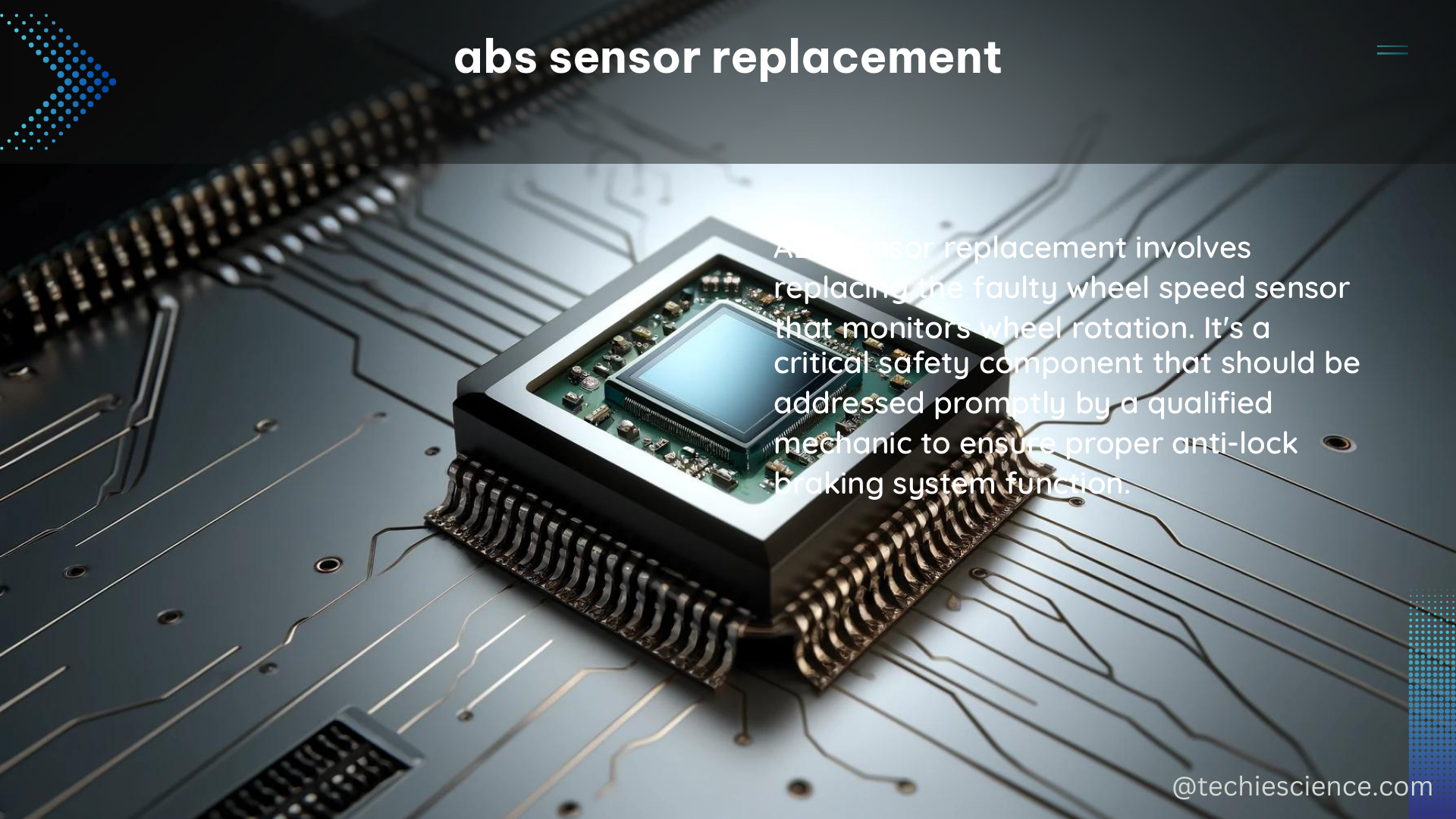Summary
ABS (Anti-lock Braking System) sensors are critical components in a vehicle’s braking system, responsible for monitoring the rotational speed of each wheel and relaying this information to the ABS control unit. When an ABS sensor fails, it can trigger the ABS warning light on the dashboard, indicating a problem that requires immediate attention. This comprehensive guide will walk you through the step-by-step process of replacing an ABS sensor, ensuring the safe and reliable operation of your vehicle’s braking system.
Identifying the Faulty ABS Sensor

The first step in replacing an ABS sensor is to identify the specific sensor that is malfunctioning. This can be done by using a diagnostic tool or scan tool to read the ABS trouble codes. The code will indicate which sensor is faulty, allowing you to target the problem area.
It’s important to note that ABS sensors are typically wheel-specific, meaning that each wheel has its own dedicated sensor. Therefore, it’s crucial to identify the correct sensor that needs to be replaced.
Locating the ABS Sensor
Once the faulty ABS sensor has been identified, the next step is to locate it on the vehicle. ABS sensors are typically situated near the wheel hub, either attached to the wheel bearing or the axle.
The location of the ABS sensor can vary depending on the make and model of the vehicle, so it’s essential to consult your vehicle’s service manual or repair guide to ensure you can accurately identify the sensor’s position.
Removing the Wheel
To access the ABS sensor, the wheel must be removed. This process requires the use of a jack and a lug wrench to safely lift the vehicle and remove the wheel.
When removing the wheel, be sure to follow the proper safety protocols, such as chocking the wheels, engaging the parking brake, and using the appropriate jack points on the vehicle.
Disconnecting the Electrical Connector
The ABS sensor is connected to the vehicle’s wiring harness via an electrical connector. This connector must be disconnected before the sensor can be removed.
Carefully inspect the connector to identify any potential damage or corrosion, as this can contribute to sensor failure. If the connector appears to be in good condition, simply disconnect it from the sensor.
Removing the ABS Sensor
With the wheel removed and the electrical connector disconnected, the ABS sensor can now be removed. This process may require the use of a sensor socket or a hammer and punch, depending on the specific design of the sensor.
When removing the sensor, be cautious not to damage the sensor or the surrounding components. Carefully extract the sensor, taking note of its orientation and position for proper reinstallation.
Installing the New ABS Sensor
Once the old sensor has been removed, the new sensor can be installed. It’s crucial to ensure that the sensor is installed in the correct orientation and that the electrical connector is securely attached.
Consult your vehicle’s service manual or repair guide to verify the proper installation procedure, as the specific steps may vary depending on the make and model of the vehicle.
Reinstalling the Wheel
With the new ABS sensor in place, the wheel can now be reinstalled. Carefully lower the vehicle back to the ground and tighten the lug nuts to the specified torque value, as indicated in the service manual.
Clearing the ABS Codes
After the new ABS sensor has been installed, the final step is to clear the ABS trouble codes. This can be done using a diagnostic tool or scan tool, which will turn off the ABS warning light and ensure the proper functioning of the ABS system.
Technical Specifications of ABS Sensors
The technical specifications of ABS sensors can vary depending on the make and model of the vehicle, but some common specifications include:
| Specification | Range |
|---|---|
| Voltage | 5V to 12V |
| Resistance | 500 ohms to 2000 ohms |
| Frequency | 100 Hz to 1000 Hz |
| Temperature Range | -40°C to 125°C |
It’s important to consult your vehicle’s service manual or repair guide to ensure that the replacement ABS sensor meets the specific requirements of your vehicle.
Conclusion
Replacing an ABS sensor is a critical task that requires attention to detail and a thorough understanding of the vehicle’s braking system. By following the steps outlined in this comprehensive guide, you can successfully replace a faulty ABS sensor and ensure the safe and reliable operation of your vehicle’s braking system.
Remember to always prioritize safety, use the appropriate tools and equipment, and consult your vehicle’s service manual or repair guide for specific instructions and technical specifications.
Reference:
- ABS wheel speed sensor – measuring vehicle speed – Arduino Forum
- ABS sensors Qu – part numbers? replace in pairs? wheel specific? – Rennlist
- How to get ABS LIVE DATA from your car in 2 minutes. – YouTube

The lambdageeks.com Core SME Team is a group of experienced subject matter experts from diverse scientific and technical fields including Physics, Chemistry, Technology,Electronics & Electrical Engineering, Automotive, Mechanical Engineering. Our team collaborates to create high-quality, well-researched articles on a wide range of science and technology topics for the lambdageeks.com website.
All Our Senior SME are having more than 7 Years of experience in the respective fields . They are either Working Industry Professionals or assocaited With different Universities. Refer Our Authors Page to get to know About our Core SMEs.